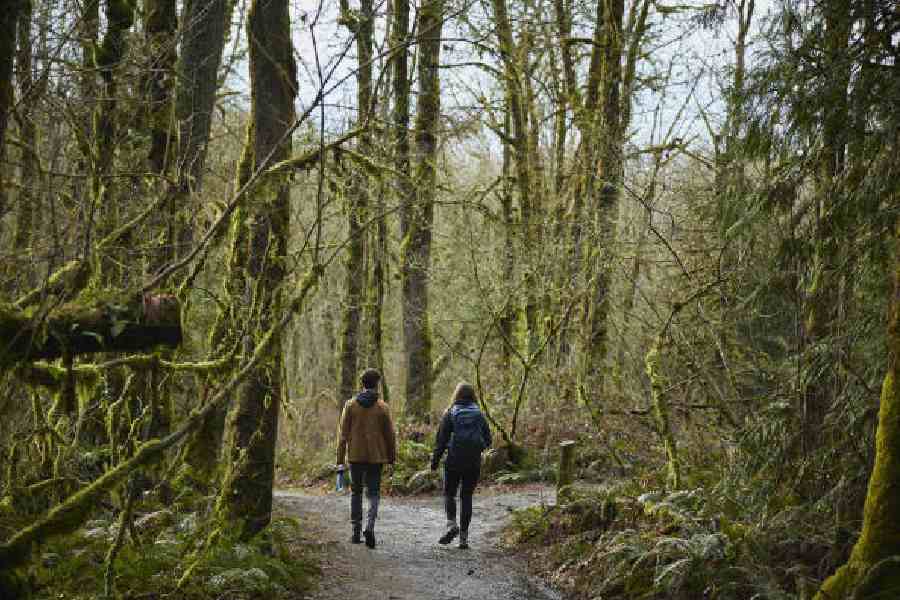Sometimes a pine cone is just a pine cone. But on a January day, the rough edges of the cone — and the lone feather sticking out of it — meant something different to Rachel Oppenheimer, 25, a counsellor at the Chesapeake Mental Health Collaborative in Towson, Maryland, US.
“Growing up, I had some challenges,” Oppenheimer said, referring to her prickly teenage past, “some struggles with managing my emotions.”
But her grandmother, who died four years ago, was soft like the feather and gave her unconditional love that reminded Oppenheimer how important it was to treat herself with “soothing tenderness”, especially when she became self-critical.
Oppenheimer and her clinical supervisor, Heidi Schreiber-Pan, were visiting Talmar, a nonprofit farm that offers therapeutic programmes and vocational training. At the farm, the only sounds were a burbling stream, trilling birds and several inches of snow crunching beneath their feet. It was the perfect location to teach Oppenheimer therapeutic techniques that make use of the natural world.
They set up camping chairs under a bright blue sky during their session — a makeshift office — and discussed how to create a circular design called a mandala. Next, they would arrange items that Oppenheimer found on the ground, each symbolising the complex feelings that stemmed from mourning her grandmother.
Schreiber-Pan is one of a growing number of therapists who are taking their therapy sessions outdoors and, in some cases, training other counsellors to do the same. They say that combining traditional talk therapy with nature and movement can help clients feel more open, find new perspectives and express their feelings, all while helping them connect with the outside world.
“It’s a sense of belonging to something bigger — and that is, I think, a really powerful ‘aha!’ moment for a lot of people,” Schreiber-Pan said. As humans evolved they spent much of their time outdoors, she added, yet our modern life is mostly spent indoors, looking at digital devices.
Outdoor therapy falls under the umbrella of ecotherapy, a broad and nebulous term that includes activities as varied as equine therapy and outings including wilderness and adventure therapy. During the pandemic, while many therapists moved online, others held sessions outside, seeking a safer way to meet in person. But the concept has been around for much longer.
Decades ago, psychiatrist Dr Thaddeus Kostrubala, author of the 1976 book The Joy of Running, was known for jogging alongside his patients. The practice never really caught on. Now, however, students are being trained in ecotherapy at a smattering of schools, including Lewis and Clark College in Oregon and Prescott College in Arizona, both in the US.
And some therapists, such as Schreiber-Pan, are creating their own curricula. In 2020, she founded the Center for Nature Informed Therapy, which offers certification and continuing education credits to any social worker or certified counsellor who completes the programme. So far, more than 100 people have graduated.
Outdoor or nature-informed therapy has especially become a big draw for men and people under 40, Schreiber-Pan and other therapists said.
Chase Brockett, 36, who lives in Portland, Oregon, US, began hiking therapy in 2022 and continued for about a year and a half, despite having to pay for sessions out of pocket. “It connects me to being human, to being alive,” he said. “Not being subject to the world, but being a part of it.”
During his sessions, he and his therapist, Aimee Frazier, would go out in all kinds of weather, including rain. “You have to be uncomfortable and just accept that’s what’s happening,” he said, a lesson that became an analogy for his anxiety.
Therapists also see other benefits: clients who are more receptive and relaxed.
“I think that for young people, therapy feels very prescribed,” said Andrew Tepper, founder of Boda Therapy, who works with adolescents and young adults in New York City and the Catskill Mountains in the US. “It’s one lane. Oh, we’re going to sit. We’re going to talk and maybe we’ll play a board game. And with that, I think, comes some resistance.”
Tepper, a psychotherapist, steers his clients toward outdoor movement — hiking or skiing — if they are receptive to it. During one retreat in early February, he took three clients snowshoeing, went on long walks and cooked lunch over a campfire.
“I believe therapy can be fun, and part of that is doing a little upfront assessment of what your clients like to do,” he said.
NYTNS










